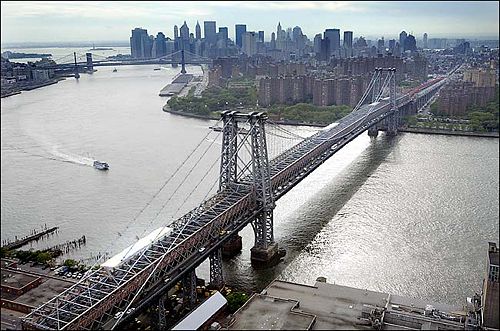From The Peopling of New York City

Contents |
In 1638, the Dutch West India Company purchased the area from local Native Americans. In 1802, Col. Jonathan Williams, a U.S. engineer, surveyed the property and named it Williamsburgh. In 1855, the City of Williamsburg was annexed into the City of Brooklyn and lost the "h."
In the 19th century, Williamsburg was a wealthy industrial area, home to Astral Oil (later part of Standard Oil), Pfizer Pharmaceutical, Domino Sugar, and several breweries. Wealthy New Yorkers, such as Cornelius Vanderbilt, stayed in elegant resorts overlooking the water.
With the opening of the Williamsburg Bridge in 1903, the neighborhood changed completely. Thousands of immigrants moved in from the Lower East Side, bringing with them overcrowding and poverty. The decline of industry in the area made conditions worser. By the 1980’s, the neighborhood changed drastically again, this time for the better. The transformation began with artists who moved from areas like SoHo, attracted by the large loft spaces, cheap rent, and convenient transportation.
Currently, Williamsburg has dozens of art galleries and is known international for its music scene and ambiance.[1]
Recently, Greenstone Realty did a survey of 200 people roaming the streets of Williamsburg and summed up the results in the following charts:[2]

Williamsburg is located in northern Brooklyn. The Bedford Avenue subway stop of the L train takes you to Bedford Avenue at North 7th Street. The Marcy Avenue subway stop of the J, M, and Z trains takes you to Broadway and Marcy Avenue on the South Side. You can also get there by walking across the Williamsburg Bridge, if you ever feel the urge to do so.
Find Out More

Influence of Art in Williamsburg, Brooklyn

Sub-Neighborhoods of Williamsburg

Real Estate and Housing in Williamsburg

A look at the Williamsburg Bridge and its Legacy
References
- ↑ A Guide to Williamsburg. New York: Big Apple Greeter, 2006.
- ↑ http://www.brownstoner.com/brownstoner/archives/2008/05/wburg_wants_cin.php#more




